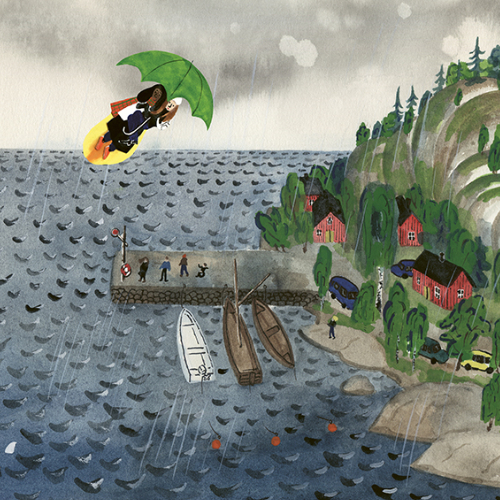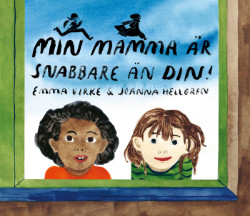< Back to posts
Emma Virke & Joanna Hellgren
Sweden

Emma Virke made her debut as a picturebook illustrator in 2010. She’s since written and illustrated many books and has been nominated for the August Prize three times. Joanna Hellgren has a degree in Graphic Design and Illustration from Konstfack University. Her work moves between illustration, comics and graphic design.
In this post, Emma and Joanna talk about the creation of My mum is faster than yours!. This fast-paced, playful and highly imaginative picturebook is published in Sweden by Lilla Piratförlaget.
Emma: The setting of My mum is faster than yours! is a preschool with two children waiting for their mums to pick them up. They start to compete. Whose mum will come first?
I remember being the last child at preschool, a bit worried about why my mum or dad was so late. But also satisfied having the place for myself. I have also felt the fear of coming too late to pick up my own children.
I started to make sketches. I wanted a linear movement and a broad book format, so that the book would almost feel like a movie. I also wanted to include hidden fold-out pages on some spreads, so that the story could make new turns. You think that the mum will catch the bus, but in the fold-out the bus has already left. This also makes the reader the animator of the images by opening the fold-out.
First, I was thinking that the story would be like a competition, one mum against the clock. Would she get to the preschool before closing? The text would go under the image, with the child’s voice, like a sports commentator. This was in 2015.
As I started trying out different heads, I suddenly had more than one mum running and I came up with the idea of having two mums competing with each other instead of one mum competing with the clock.
This made the story more dynamic, and so I rewrote the story with one more voice from a second child. Since the only text is the dialogue between the children, I had to think a lot about making it obvious when there is a change of voice, with the children responding to each other.
To make it even more clear, I added different colours to the text, helping the readers to change their voices when reading out loud. But the most important thing about the text wasn’t which child was speaking. It was trying to find the authentic children’s voices. The way they speak when playing. One example is that I let them change the tense several times, between the present and the past.
”But then my mum RAN for the bus.”
”My mum IS already on the bus!”
Since I had a lot of other book and art projects going on already, I put the story in a drawer for later. Maybe it was all the different vehicles and transportation methods that I wanted to include but didn’t feel like drawing. And as years went by, I started to think that I wasn’t the right person for the job. I have worked with amazing illustrators like Ida Björs, Emelie Östergren and Japanese Fumi Koike, so I know what joy and excitement it brought to have other artists interpret my story. It can really become something else than I could have imagined. So after talking with my publisher I decided to ask one of my favourite illustrators, Joanna Hellgren. We have known each other since 2009, when we were both winners in the same children’s book competition.
“Then there was a road construction. No cars can pass, the police say.”
“No buses either in that case. Everyone has to get off. But my mum can go with a man on a moped.”
Joanna: Emma contacted me in early 2020 and asked if I wanted to read her manuscript. I like Emma’s books very much, both text and pictures, so I was curious about why she didn’t illustrate the book herself. She explained, as in her text above. The idea seemed interesting to me, so I got to read it and instantly liked the text. I was happy to collaborate with Emma and the publisher Erik Titusson for the first time, although I felt a certain pressure illustrating for an illustrator.
One month later, we had our first meeting. It happened to be February 28, and a few days later, the pandemic had hit Europe and Sweden. That affected the working process in that we didn’t meet up for a long time, and I did all the illustrations at home, often at night. Even though Swedish day care didn’t close, kids had to stay home for one week for every little sneeze, which was often with a three-year-old. Our emails about the book were full of descriptions and analyses of colds: our own and other peoples’. The fear of accidentally killing someone was real.
At the time, Emma didn’t show me her own sketches for the book, I don’t recall seeing them until now, which is fun, because they have similarities to how mine turned out. But she had the text set out in two different colours to separate who is talking, and ideas for pages where the secret fold-outs would work the best. In that first February meeting, we set the size of the book and layout for the text, with “subtitles” on white at the bottom of all the pages with the competing mothers, but the text included in the picture in the pages where the children are visible. The low and long format suited the competition as the mothers rush through the landscape. We soon decided that the text would be handwritten (by me) in two different colours to match the children’s clothing.
“Yes, but then my mum takes out her super-fast running shoes. Now she’s faster than your mum.”
“Oh no, the moped was faster!”
I wanted to work on paper, after having worked in more digital ways in my last books (Tiger, Tiger, Tiger, written by Åsa Lind and published by Rabén & Sjögren in 2019, is one of those).
It took a little experimenting in the beginning to find the right form for this story, but that is usually the case for me. In the beginning, I often hate my pictures and think of alternative careers. I worked in aquarelle and gouache, but also parts of collage, especially for the characters. I like being able to move them around.
I also used black ink lines here and there, in details. But not too many, I wanted to keep a naïve and simplified style, even in the almost realistic setting. I proceeded to make pencil sketches that I mostly would follow and also test the colours on.
“But then my mum took a taxi, which drove really fast, past the bus.”
The first picture, the one of the preschool, took many tries. One of them I gave to Emma afterwards. In the process, the trees became wilder and simpler, and the black lines came in. After finding the style for that page, the rest got easier.
Over to the kids in the window. That also took several versions before I was happy.
“Soon, my mum comes to pick me up.”
“But my mum will be here first!”
Same thing with the first spread where the mothers start competing. In the first version they are both visible twice, to match what the kids say. But that didn’t feel necessary later.
“No, because my mum has already left work.”
“But my mum has a bike, so she gets here first anyway.”
The fold-out pages were a bit tricky, but funny! In the first one, the mum with a flat tyre on her bike is trying to catch the bus. When we open the fold-out, we see that she missed it, but the other mum is in the bus. I thought a lot about how to make the background without ruining the illusion that the running mother and the bus had moved forward. This was mainly a problem in the city pictures.
“But then my mum RAN for the bus.”
”My mum IS already on the bus!”
“Now the bus goes! And your mum missed it!”
Emma had included many methods of travel: bicycle, bus, taxi, moped, ferry, and a rocket-driven umbrella! So the families had to live on an island outside the town. I drew a landscape that looks like the Stockholm archipelago without any exact reference. I really like that landscape and would love to live in that setting, especially at that time of spending so much time at home.
“Then they flew over the water.”
“They couldn’t lose their grip!”
“Because there were many sharks now.”
When the mothers land in the preschool yard, I had first drawn the kids still looking out of the window. Emma thought it better to have them play with something, so that picture was changed. The interior was copied from my kid’s preschool entrance at the time.
Emma: I really love the way Joanna made this story her own by adding hilarious side characters to the story, like the lycra man on the bicycle. I also have a favourite scene when one of the mums misses the ferry and decides to dive into the water to swim when she meets a shark. We can’t see the swimming mum here, because she has been eaten by the shark, says the other child. But has she really? There is no action taking place. No blood, but yes, it looks like the shark is chewing on something. For me it was unexpected with this still and slow image of the shark that makes the turn of the story so much better. The reader can get both worried and uncertain, and the lack of action makes the scene even more dramatic.
“Yes, but then she couldn’t drive on the pier, so my mum ran past and caught the boat. Your mum did not.”
“But my mum dove into the water and swam really fast, past the boat!”
“But then came a shark and ate her! Yummy!”
“No, because she swam even faster!”
“But then she got tired, and the shark swallowed her.”
“It did NOT!”
Joanna: I remember this working process as being more social than many others. There was so much to discuss about the fold-outs and other subjects, so we kept in touch, even though we only met twice with Erik. Emma’s ideas for the pictures were always good, so I usually just included them. I tend to feel nervous about my own part in making books until they have their final form. That was the case with this book as well, but ever since it arrived from the printers, I’ve felt happy and proud with it.
Emma: I also feel super-happy about the book. It was so much fun to return to the story now that it has also turned into a theatre play, interpreted by Stockholm-based Teater Barbara. So much energy on stage and laughter among the kids in the audience.
We take this energy with us now, when starting our second book together. We will meet the same children, but this time they are competing about who has the smartest dog!
Joanna: It will be great fun to draw clever dogs!
Illustrations © Joanna Hellgren. Post edited by dPICTUS.
Min mamma är snabbare än din! /
My mum is faster than yours!
Emma Virke & Joanna Hellgren
Lilla Piratförlaget, Sweden, 2021
Two children are waiting for their mums. Who gets to preschool first? Which mum is the fastest? It becomes a race like no other – with all kinds of vehicles, fights with sharks, and a pair of really fast running shoes! This is a story that barely fits within the book cover – how lucky then that several pages are fold-outs!


























